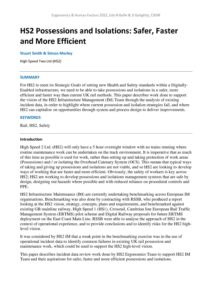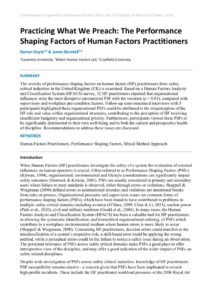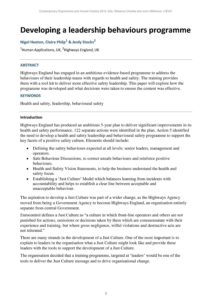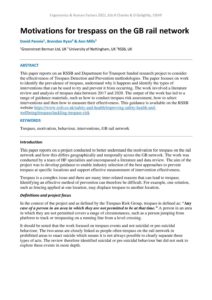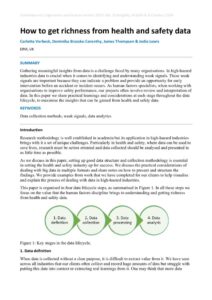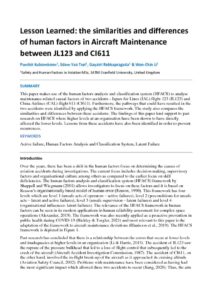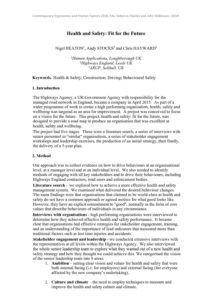Health & Safety
HS2 Possessions and Isolations: Safer, Faster and More Efficient
| Document | Author Stuart Smith & Simon Morley |
| Abstract For HS2 to meet its Strategic Goals of setting new Health and Safety standards within a Digitally-Enabled infrastructure, we need to be able to take possessions and isolations in a safer, more efficient and faster way than current UK rail methods. This paper describes work done to support the vision of the HS2 Infrastructure Management (IM) Team through the analysis of existing incident data, in order to highlight where current possession and isolation strategies fail, and where HS2 can capitalise on opportunities through system and process design to deliver improvements. |
Practicing What We Preach: The Performance Shaping Factors of Human Factors Practitioners
| Document | Author Darren Doyle, & James Blundell |
| Abstract The severity of performance shaping factors on human factors (HF) practitioners from safety critical industries in the United Kingdom (UK) is examined. Based on a Human Factors Analysis and Classification System (HFACS) survey, 32 HF practitioners reported that organisational influences were the most disruptive encountered PSF with the vocation (p < 0.01), compared with supervisory and workplace pre-condition factors. Follow-up semi-structured interviews with 5 participants highlighted these organisational PSFs could be attributed to the misperception of the HF role and value within organisational structures, contributing to the perception of HF receiving insufficient budgetary and organisational priority. Furthermore, participants viewed these PSFs to be significantly detrimental to their own well-being and to both the current and prospective health of discipline. Recommendations to address these issues are discussed. |
Developing a leadership behaviours programme
| Document | Author Nigel Heaton, Claire Philps & Andy Stocks |
| Abstract Highways England has engaged in an ambitious evidence-based programme to address the behaviours of their leadership teams with regards to health and safety. The training provides them with a tool kit to deliver more effective safety leadership. This paper will explore how the programme was developed and what decisions were taken to ensure the content was effective. |
The Impact of Government Health and Safety on Healthcare and Ergonomics in the United States
| Document | Author Marc CHRISTIAN, Jeffrey E. FERNANDEZ, Anand SUBRAMANIAN, and Brandy Farris WARE |
| Abstract The purpose of this paper is to examine a major cost associated with the healthcare industry: health and safety. The labor regulatory agency (OSHA) in the USA have recently targeted healthcare facilities with high fines for a number of high-cost injury categories. The reasons for and implications of this enforcement policy are discussed, and a case study regarding ergonomic interventions in healthcare is presented to emphasize the importance of proactive risk reduction measures. Additional benefits of the intervention included increased productivity, throughput, and employee satisfaction. |
Motivations for trespass on the GB rail network
| Document | Author David Pennie, Brendan Ryan & Ann Mills |
| Abstract This paper reports on an RSSB and Department for Transport funded research project to consider the effectiveness of Trespass Detection and Prevention methodologies. The paper focuses on work to identify the prevalence of trespass, understand why it happens and identify the types of interventions that can be used to try and prevent it from occurring. The work involved a literature review and analysis of trespass data between 2017 and 2020. The output of the work has led to a range of guidance materials, such as how to conduct trespass risk assessment, how to select interventions and then how to measure their effectiveness. This guidance is available on the RSSB website https://www.rssb.co.uk/safety-and-health/improving-safety-health-and-wellbeing/trespass/tackling-trespass-risk |
How to get richness from health and safety data
| Document | Author Carlotta Vorbeck, Dominika Brzoska-Corenthy, James Thompson & Jodie Lewis |
| Abstract Gathering meaningful insights from data is a challenge faced by many organisations. In high-hazard industries data is crucial when it comes to identifying and understanding weak signals. These weak signals are important because they can indicate a problem and provide an opportunity for early intervention before an accident or incident occurs. As human factors specialists, when working with organisations to improve safety performance, our projects often involve review and interpretation of data. In this paper we share practical learnings and considerations at each stage throughout the data lifecycle, to maximise the insights that can be gained from health and safety data. |
Towards an Alternative Approach to Safety in Construction
| Document | Author Eleanor HARVEY, Patrick WATERSON and Andrew DAINTY |
| Abstract Many safety-critical industries are moving away from compliance-based safety measures and looking for solutions incorporating adaptability and resilience. However, there are significant challenges when considering applying such measures to construction. The unique design of projects prevents the development of transferable experience, and the use of subcontracting limits opportunities for long-term investment in workers. This paper contrasts the traits of resilient organisations with the characteristics of the construction industry. It is proposed that construction could become more resilient by incorporating employee-level – as opposed organisation-level – aspects of the ‘Adaptive’ age of safety. Further research is needed to understand how the psychological factors believed to underpin a resilient response to risk can be developed. |
Lesson Learned – the similarities and differences of human factors in Aircraft Maintenance between JL123 and CI611
| Document | Author Punthit Kulsomboon, Edem Yao Tsei, Gayatri Rebbapragada & Wen-Chin Li |
| Abstract This paper makes use of the human factors analysis and classification system (HFACS) to analyse maintenance-related causal factors of two accidents - Japan Air Lines (JAL) flight 123 (JL123) and China Airlines (CAL) flight 611 (CI611). Furthermore, the pathways that could have resulted in the two accidents were identified by applying the HFACS framework. The study also compares the similarities and differences between these accidents. The findings of this paper lend support to past research on HFACS where higher levels at an organisation have been shown to have directly affected the lower levels. Lessons from these accidents have also been identified in order to prevent recurrences. |
Health and Safety: Fit for the Future
| Document | Author Nigel HEATON, Andy STOCKS and Chris HAYWARD |
| Abstract |

